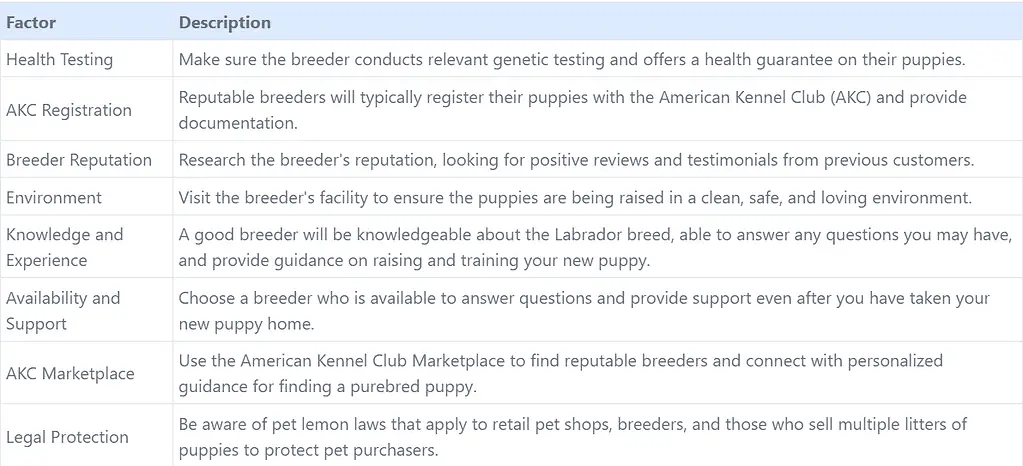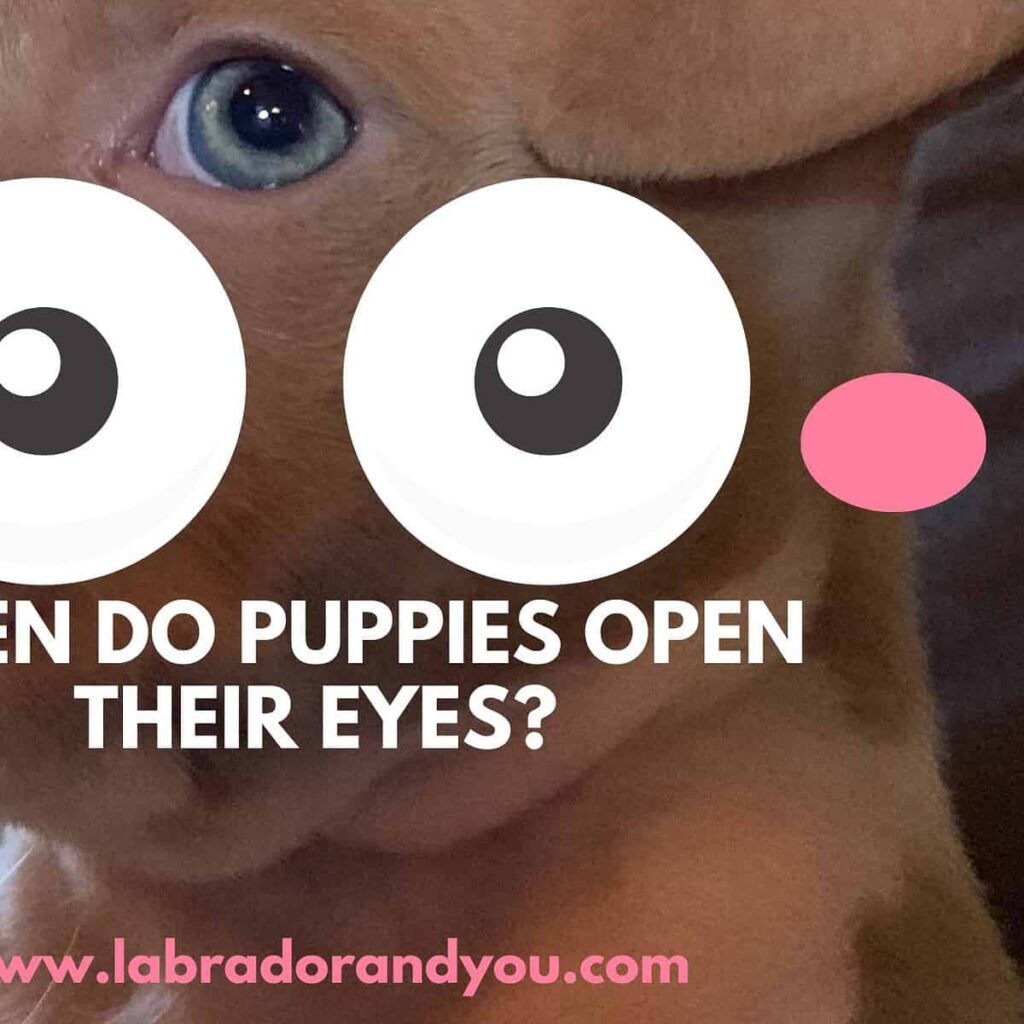A well-rounded approach to choosing a labrador puppy from a litter involves several key considerations. The best labrador puppy comes from a breeder with a credible reputation and proven stock. So how to pick a labrador puppy from a litter?
- Begin by speaking with the breeder and inquiring about the puppy’s appetite and eliminations.
- Next, take note of the litter mates’ behavior – do they interact well together?
- Examine the puppies’ appearance, coats, size, and overall health.
- Observe their movement and activity levels.
Considering these factors, you can make an informed decision when selecting a labrador puppy from a litter. Always go for a reputable breeder and choose from one of their litters. Choose healthy pups as per breed standards.
Health Problems To Look Out For in Labrador Retriever breed?
Labrador puppies can have health issues. Understanding the breed’s potential genetic problems is imperative before selecting a dog. Labrador Retrievers are prone to below health issues.
- Hip dysplasia: A common joint problem in Labrador Retrievers, affecting the hip socket and causing mobility issues.
- Elbow dysplasia: Similar to hip dysplasia, but affects the front legs’ joints. It has the potential to cause arthritis and pain.
- Obesity: Labs overeat and gain weight quickly if not monitored closely. It can lead to additional health complications.
- Ear infections: Due to their floppy ears, Labs are more susceptible to ear infections. It’s important to check and clean their ears routinely.
- Eye problems: Clear eyes with no redness or discharge are signs of a healthy Lab puppy. Any eye issues indicate genetic concerns like progressive retinal atrophy or retinal dysplasia.
- Exercise-induced collapse: Some Labs may experience sudden muscle weakness following strenuous exercise. Be mindful of your pup’s energy levels during playtime.
- Wobbler disease: Though rare, this neurological condition causes an unsteady gait in affected dogs. It can be linked to genetics.
- Arthritis and stiffness: Labs may experience joint wear and tear as they age. Leading to arthritis development or stiffness in movement.
Working Type Vs. Show Type Labradors
The working dog Labrador was bred as a hunting dog for retrieving, and other physical activities.
Show-type Labradors are bred to meet specific standards. They have broader bodies and thicker coats. They excel in dog shows and competitions regulated by organizations like the American Kennel Club.

What To Look For When Picking A Puppy From A Litter?
Check The Parents’ Health History And Ancestry
Always inquire about the parents’ health history and whether they had any genetic issues. Responsible breeders are transparent about dog health and offer certifications as proof.
Find a breeder who offers reasonable guarantees against inherited defects. A good breeder will have written documentation.
Choosing Best Lab Puppy With Health Clearances
Always go for the healthiest pup. A healthy puppy is not just about its physical appearance. Both its parents must have health clearances and be free of genetic defects.
The lineage and genetic makeup of both parents is crucial. Inbreeding can lead to genetic issues. Reliable breeders avoid breeding dogs that are too closely related.
The breeder should be able to provide information about any health issues or concerns within their breeding program.
Checking the available health clearances or certifications for both parents gives further insight.
Good breeders ensure their female dog has an OFA certification and eye clearance by CERF.
Research is key in finding reputable breeders. Examine each prospective puppy’s lineage and breeding history carefully.

Select A Reputable Breeder
Breeders Of Repute keep the pups physically and mentally fit. Get recommendations from friends or veterinarians.
Check with breed clubs or go directly to the American Kennel Club website for a list of registered breeders. Go for one with enough positive feedback.
Once you have narrowed your search, ask the potential breeder about their breeding practices and policies.
Viewing The Puppies In Person
Visit the breeder and assess their facilities for cleanliness, comfort, and overall well-being. When you arrive at the kennel, watch how they interact with each other.
This will give insights into the pup’s personality. How pups respond when someone picks them up speaks volumes.
Some may be shy or hesitant, while others can be too aggressive. Finding that perfect balance is key.
Ideally, the right pup should wag their tails happily and be curious without fear or discomfort.

Choosing Between A Dog Or Bitch
Both genders have unique qualities.
Male Labradors grow larger and possess more energy than their female counterparts.
Females are easier to train and are more affectionate.
Purchasing a female would allow you to breed her later down the line. Breeding comes with risks for a mother dog and pups if not done properly, be mindful.
Avoiding Labrador Health Issues
Look for breeders who breed pups with clean ears, bright eyes, shiny coats, and overall good health.
Avoid buying from a pet store or online. The living conditions of the parent dogs are vital.

How To Choose A Puppy From Its Litter Mate?
Observing How Puppies Interact With Their Littermates
Observing how the puppies interact will tell you about their personality.
Littermate syndrome can occur when two puppies of a similar age are raised together and become overly dependent.
Never take home two puppies from the same litter unless you have experience raising multiple dogs at once.
Choose a puppy with positive interactions by observing how they interact.
Lifting Your Puppy Off The Ground
Lift each pup off the ground and observe their reaction. Here are some steps to follow:
- Lift the puppy gently: Use a calm and gentle approach when picking up your pup. This allows you to see how they react to being held.
- Cradle the puppy in your arms: Hold the pup close to your body. Cradle them with one hand on its chest and the other under its hindquarters.
- Observe the pup’s reaction: Pay attention to how the pup reacts while being lifted off the ground. A healthy and well-socialized pup will most likely be calm and relaxed.
- Check for any signs of discomfort: While holding your dog, check for discomfort or pain, such as whimpering or squirming.
- Repeat with all puppies: To make an informed decision, it’s essential to lift them from the litter individually.

Cradling Your Puppy
Cradling reveals how comfortable they are with handling.
- Gently stroke its back and see if it relaxes in your arms.
- Observe the position of the dog’s ears when cradling them. The dog is nervous if the ears are perked up or alert.
- Relaxed and floppy ears suggest the pup is easy and comfortable.

Testing Sound Reactivity And Stimuli Response
Assess their sound reactivity and response. Here are some tips:
- Observe the dog’s reaction to loud noises like clapping or dropping an object. A healthy puppy will not show fear or excessive agitation at these sounds.
- Test the dog’s response to sudden movements by making quick gestures. A good response is calmness and curiosity.
- Try introducing the puppy to new objects or surfaces and observe how they react. Include things like a new toy or walking on a different surface.
- Pay attention to the dog’s body language during these tests, including tail wagging and overall demeanor.
- If possible, conduct these tests in different environments to see how the dog reacts in new surroundings.
Encouraging Your Puppy To Follow Your
Try to establish a bond between you and your pet. Increase the distance from which you call out their name. They will learn how to find you when called upon.
Social Dominance
Remember that sociability and temperament are important factors in seeing if the pup is a good match.
- Look for a pup that is not excessively submissive or dominant with its littermates.
- A dominant pup is friendly and social but can steal toys from other pups or play rough.
- An overly submissive pup may struggle to stand up for themselves or assert their needs.
- Observe the puppies to get a sense of each individual’s personality and level of social dominance.
- Consider how the pup interacts with you – do they follow you around or shy away? This can give you an idea of how they might interact with other humans.
One behavior to look out for is if the pup falls and acts injured. This may indicate potential health issues or weakness, affecting the dog’s ability to grow into a healthy adult.
Where To Buy Labrador Puppies
When buying a Labrador puppy, choosing the right breeder is essential. Check our post on the best labrador breeders in the USA.

Adopting A Puppy From A Shelter
Adopting a shelter puppy is an excellent option. Many shelters offer puppies of different dog breeds, including Labradors.
When adopting from a shelter, ask about the dog’s health and temperament history.
Some rescue organizations have medical records from previous caretakers. Be patient when bringing home an adult dog or young labrador that has lived in multiple homes.
Especially true if there were any prior abuse issues or neglectful treatment before. Shelters require applications and interviews with prospective pet parents to find the right puppy.
Avoiding Pet Store Puppies
Pet stores source their puppies from mills or backyard breeders. They prioritize profit over the dogs’ health. Puppies born and raised in these facilities are often sickly and lack proper socialization.
How to Understand Labrador Puppy Health?
Breeder Behavior
A good breeder asks potential buyers about their lifestyle, living arrangements, and dog experience. They provide health clearances for the litter’s sire and dam.
Observing how breeders interact with their puppies when visiting them is important. Good breeders should allow potential buyers to play with the puppies.
Be wary of breeders who do not seem invested. It indicates that they are running a “puppy mill” operation.
Bringing Backup
It’s always a good idea to bring backup. Bring someone who can offer their opinion during the decision-making process. It could be your partner, a trusted friend, or a veterinarian.
This helps you stay level-headed. They may notice something about the puppies you didn’t pick up on. Having an extra set of hands can make handling easier.
What Are Basic Considerations For Prospective Labrador Owners?

Activity Level
Labrador Retrievers are high-energy dogs bred originally as hunting dog. They need regular exercise. This helps maintain a healthy weight and prevents destructive behaviors.
Consider your activity level when choosing a Labrador. An active Labrador may be your perfect companion if you enjoy outdoor activities like hiking or running. It may not be a perfect fit if you prefer a more low-key lifestyle.
Labradors thrive on human interaction and love playing games like fetch or tug-of-war. Providing mental stimulation reduces unwanted behaviors such as chewing or digging.
A good rule of thumb is at least 30 minutes of daily physical activity for puppies up to six months old. One hour per day for adult Labradors over six months old.
Financial Responsibility
Owning a Labrador is an amazing experience. Understanding the financial responsibility that comes with it is essential.
Dogs require regular visits to the vet for shots, checkups, and any necessary medical treatment. Food costs increase quickly as puppies grow and consume more food.
Other expenses include toys, leashes, and collars or playpens to keep them safe when they can’t be supervised. All these expenses must be budgeted before bringing your pup home.
Having Children Or Other Pets
It is important to assess whether they will get along well with children and other pets. Labradors are patient and gentle dogs. But proper socialization with children and other puppies prevents potential conflicts.
If you have young children, teaching them how to interact safely with the new puppy is important.
This includes basic safety rules such as not pulling the puppy’s tail or ears. Avoiding rough play that could lead to injury.

If you already have another pet accustomed to being an only child, introducing a new Labrador puppy will require adjustment. Proper supervision during pet interactions is needed.
Work Schedule
These dogs need regular exercise and mental stimulation. People with long work hours or unpredictable schedule fails to provide adequate attention.
If you can arrange dog walkers or daycare services while you’re away, it’s beneficial.
A labrador was bred as a hunting dog or working dog and enjoyed having jobs to do. If your job involves outdoor activities such as hiking or hunting, bring them along. It is a great way to bond and keep them active.
Assistance With Puppy Care
Having some assistance in caring for the new pup goes a long way.
- Hire a dog walker or pet sitter to care for the puppy while you work.
- Enrolling in a puppy training class is also fantastic.
- Having someone who can help when you’re on vacation or need an extra hand. Consider hiring a boarding facility specializing in Labradors.
Living Arrangements
These dogs have high energy levels. An apartment or small space without access to outdoor areas may not be the best fit.
A house with a large yard or nearby parks is well-suited. Labs are friendly and social animals that bond well with people and other pets.
Supervise interactions between young children and puppies, as they can be prone to unintentional roughhousing.
It may cause harm to either party. Smaller animals like cats should be introduced slowly until the puppy learns to behave around them.
What NOT To Do When Choosing A Puppy?
Avoiding Puppy Mills
These mills prioritize profit over animal welfare, leading to inadequate animal care. One option is to adopt from a shelter or rescue group.
When you bring a puppy mill dog into your home, be patient and protect them from things that scare them. Research and ask questions about the puppy’s parents to avoid bad dogs and backyard breeders.
Warning signs include the inability to produce the necessary certificates and answers about the living conditions. Avoid buying pups from dog stores too.
Avoiding Impulse Buys
Avoiding impulse buys will increase your chances of bringing the right labrador puppy home. One that is healthy, compatible with your lifestyle, and well-suited for your home.
- Do your research: Before visiting a breeder or shelter, research the breed and learn about the characteristics of Labrador puppies.
- Visit the litter more than once: Don’t make the mistake of falling in love with the first cute Labrador you see. Take your time to visit the litter more than once and observe them in different situations.
- Resist pressure from breeders or sellers: Some breeders or stores may pressure you to buy their puppies quickly before someone else does. Don’t let this influence your decision-making process.
- Consider other factors besides appearance: While it’s easy to get hung up on looks, personality, temperament, and behavior are equally important.
- Remember the commitment involved: Owning a Labrador requires patience, time, and money. Avoid letting emotions drive your decision without considering if they can be met adequately.
Avoiding Getting Two Puppies At Once
Bringing home two Labrador pups from the same litter can lead to serious behavioral problems like Littermate syndrome leading to separation anxiety.
Raising two puppies simultaneously means you’ll need double the time for training, socialization, exercise, and veterinary care.
Building a strong bond with one before considering adding another dog. Only bring two if you are experienced dog owner

Avoiding Breed Stereotypes
Breed stereotypes can be misleading and may result in the selection of the wrong puppy.
- No two Labradors are the same: While Labradors share certain characteristics as a breed, individual personalities and behavior vary widely.
- Avoid making assumptions based on appearance: A Lab from working lines may look different from one bred for showing purposes.
- Get to know the individual pup: Spend time with each puppy in the litter to understand its unique personality and temperament.
- Discuss your lifestyle with the breeder: The best breeder will consider your needs and make suitable recommendations.
- Remember that behavior is learned, not just innate: Even if a dog has tendencies toward a specific behavior, it can be trained. They can be taught more desirable behaviors over time.
Do not be afraid to walk away if something doesn’t feel right. This could include noticing warning signs such as lethargy, excessive fear, or aggression toward other dogs.
Walking away can be difficult when your heart is set on a particular litter mate. Always trust your gut instincts when deciding which dog is best for you.
FAQs
Which color labrador dog is the most popular?
Labrador dog comes in three popular colors – yellow, black, and chocolate. Each dog has a unique personality. The color choice entirely depends on the owner’s taste.
The chocolate lab has a comparatively shorter lifespan. Hence, yellow and black labs are more popular dogs.
How can you tell if a Labrador puppy is good quality?
Visual assessment, pedigree reports, and DNA tests are crucial to determine the quality. Visual assessment is the least popular as it restricts to the breed standards alone.
Which puppy should you pick from the litter?
A pup who is neither first nor last when called is a good sign. It means the puppy is neither too shy nor a bully with other litter mates. They are usually trainable, safe for traveling, and adapt to any lifestyle.
What is the hardest age for a Lab pup?
The adolescent period of a dog is the hardest age to raise them. They act like teenagers and forget everything taught before. This phase is unique to each puppy. It usually begins when the dog is eight months and lasts up to 2 years.
What are the red flags when picking out a puppy?
The biggest red flag is a dog breeder that will not allow you to see the pups. Choose a healthy pup with appropriate health testing and certificates. A labrador breeder that asks for pre-deposits must be avoided in some cases.
Author Profile
- Site Owner And Dog Lover
-
Aritra, the founder of Labradorandyou.com, is a lifelong dog lover whose passion ignited for Labradors for their loyalty and intelligence. With extensive research and personal experiences, Aritra has become a Labrador expert, offering a rich resource on the breed. Labradorandyou.com provides reliable, timely, and evidence-based information, including Labrador-specific product reviews, training techniques, and care tips.
Labradorandyou.com was born out of Aritra's passion and his desire to share his profound knowledge about the breed. The site serves as a comprehensive resource, offering a wealth of up-to-date information for Labrador owners and enthusiasts alike
Also by the author
-
 Lab-TypesNovember 17, 2023Old Dog Seizures: Causes, Symptoms, and Treatment Options
Lab-TypesNovember 17, 2023Old Dog Seizures: Causes, Symptoms, and Treatment Options
-
 Lab-TypesNovember 17, 2023Why Is My Dogs Poop Yellow? 8 Reasons & Solutions
Lab-TypesNovember 17, 2023Why Is My Dogs Poop Yellow? 8 Reasons & Solutions
-
 ReviewsNovember 17, 2023The Only Hill’s Science Diet Review You Need To Read
ReviewsNovember 17, 2023The Only Hill’s Science Diet Review You Need To Read
-
 Lab-TypesNovember 17, 2023How To Adopt An Emotional Support Dog?
Lab-TypesNovember 17, 2023How To Adopt An Emotional Support Dog?





